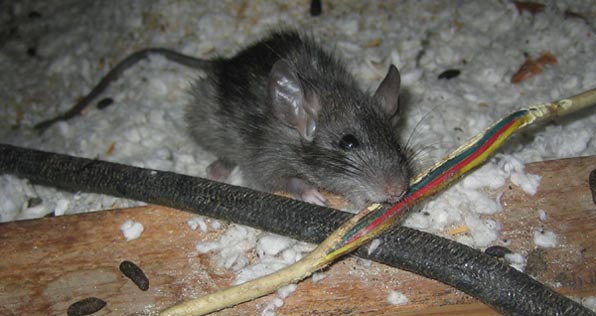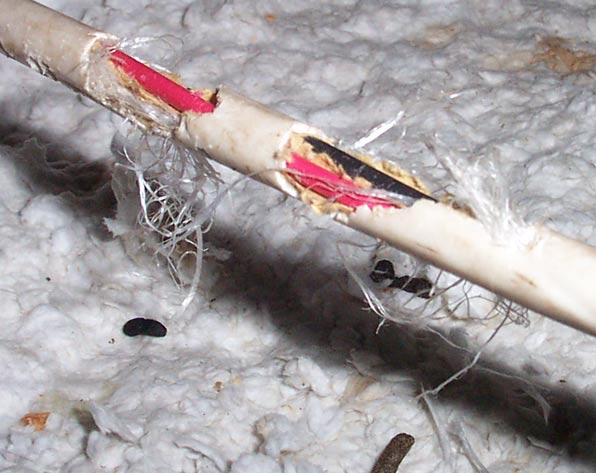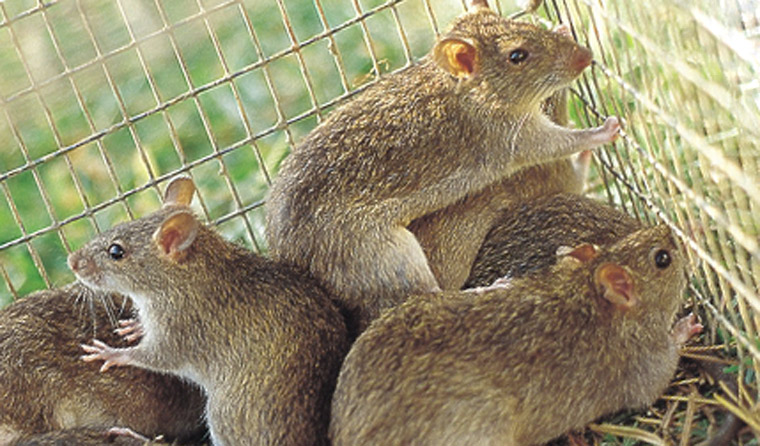-
info@aaanimalcontrol.com
Call us for help in your town
Humane Wildlife Education
Rats and Other Rodents Chew on Wires
Need rat removal in your hometown? We service over 500 USA locations! Click here to hire us in your town and check prices - updated for year 2020.

Rats and many other rodents gnaw. It's a common part of their behavior. I've read that rat teeth continually grow, at a rate of about five inches per year. In order to keep the length of the teeth in check,
the rats chew on things to wear the teeth down. It's the same reason a cat scratches, in order to wear down its claws. Rats may chew on a variety of surfaces, but they often seem to select something somewhat
soft - and wires, including electrical wires, fit the bill nicely. An unfortunate side effect of this gnawing is the potential for fire hazards. Electrical wires often lay across wooden beams in an attic, and
the exposed wire, without its insulating covering, can overheat the wood and cause it to burn.
Find out whether or not a pest control company remove a rodent
Many house fires of unknown origin are believed to be electrical fires as a result of rodent chewing. It's a simple
concept - rats love to live in attics, they love to chew wires, there's electrical wires in the attic, and voila, they get chewed upon. I very commonly spot chewed-upon electrical wires. In fact, the rats often
select the exact areas where the wires meet the wood - probably because they're already using the wood beam as a pathway, and the location is convenient. So I see real fire hazards from time to time.
We can help answer What property modifications will keep down rodent populations?

If you've got rats in the attic, be aware that the problem involves more than just some annoying scratching noises at night. It involves real threats to your health, property, or safety.
What Materials Can Rodents Chew Through?
Need wildlife removal in your hometown? We service over 500 USA locations! Click here to hire us in your town and check prices - updated for year 2020.In terms of materials, you have very few choices when it comes to sealing and repairing the damage left behind by invading rodents. Rats particularly, can chew through almost anything, and this includes wood, plastic, ceramics, drywall, some concretes, and even some softer metals too. When we warn you that no materials can ensure your home is rodent-proof, we weren't kidding. That's why you would keep an eye on your home, on the outside as well as the inside, to ensure no holes or patches of damage pop up. If they do, you will have hopefully caught the problem before it arises, sealing the hole before too many furry invaders move in with a bunch of their friends.

Glass isn't safe, nor is vinyl, mortar, bricks, cinderblocks … Rats teeth constantly grow. They need to chew and gnaw constantly to help file them down, much like humans need to file down or cut their finger and toe nails. If the rat can chew, gnaw or grind the material down, it won't take them long to make their way through.
If you spot rat or mouse holes, you should seal them, but you will first need to start by making sure all traces of the rodent itself are gone. You can't seal all the holes leaving an animal trapped in your home. It won't be able to get out. It'll either stay inside your home, chewing its way out and creating more holes, or it'll die. Then you'll have the smell, diseases, and carcass of a dead rodent to find and dispose of. It's not a nice job, and it could even mean the necessary cutting-out of square patches of your wall if you can't reach the creature any other way.
One of the best materials to use when trying to seal rat and mouse holes is wire wool. This can be shoved into holes before expanding foam is used around it to keep it in place. The rodents can still chew through the expanding foam, but they won't be able to chew through that metal, wire wool section, and it'll hurt their teeth a lot when they try. They'll soon give up, provided they can't find a way around it. Do not underestimate the stubbornness and sheer determination of these creatures, however, or the strength of their front teeth!
You may want to click on one of these rat guides that I wrote:
How much does rat removal cost? - get the lowdown on prices.
How to get rid of rats - my main rat removal info guide.
Example rat trapping photographs - get do-it-yourself ideas.
Rat blog - learn from great examples of rat jobs I've done.


















